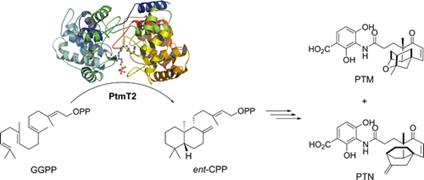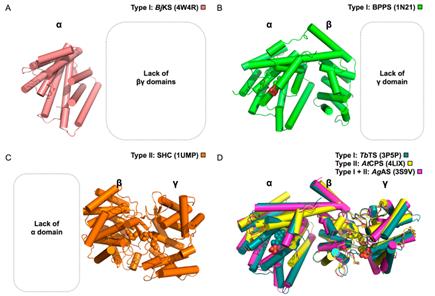


一个著名的天然化合物家族——被称为“萜类”,有一个奇怪的进化起源。特别是,一个有关未来药物发现的问题让科学家们十分困惑:大自然究竟是如何制造出了这些分子?
来自斯克里普斯研究所(TSRI)佛罗里达州校区的科学家进行的一项研究,填补了这个进化之谜的一个缺失环节,从而确定了制造这些化合物不可或缺的一个蛋白质家族一个以前未知的结构。
萜类主要是由植物生产的,是一个分子家族,包括一些最知名和成功的天然原料制成的药物,例如抗癌药物紫杉醇。总共有超过65000种已知的萜类化合物。
天然化合物,如萜类化合物,通常是由众多的酶聚集在一起制成的,就像乐高建筑模型。在这项新的研究中,该研究团队专注于称为萜类合成酶的酶,它是在植物和细菌中发现的。
这项研究是由TSRI的沈奔(Ben Shen)教授带领完成的,研究结果最近被提前发表在美国化学学会杂志《Journal of the American Chemical Society》。这项研究在这一类蛋白质的结构生物学方面取得了一定进展,除此以外,这项新的研究结果也可能会影响药物的发现,使得这些蛋白质、进而它们的衍生化合物的工程学,在未来变得更加容易。
沈奔教授多年来一直致力于微生物来源天然产物的生物合成机制及其调控的研究,综合应用有机化学、生物化学、天然产物化学和分子生物学技术,对微生物来源天然产物的化学结构、生物合成酶及基因进行阐述,并以此作为发现和开发新药的新方法,先后在Nature、Science、PNAS、JACS、JBC、Cancer Res、Nature Chemical Biology等国际一流学术期刊上发表系列论文。相关阅读:沈奔教授新发Cell文章:天然产物研究的黄金时代;华人教授PNAS抗癌药开发新见解 。
沈教授和他的同事们利用X射线晶体学——冻结一个蛋白的原子结构,然后用X射线轰击它以创建它的一个快照,从而制备了一个详细的结构模型,让我们对于细菌二萜类合成酶以及这类酶在自然环境中如何起作用,有了一个更好的了解。
TSRI研究助理Jeffrey Rudolf和Liao-Bin Dong是本文共同第一作者,他说:“我们发现,这个细菌的版本与植物版的结构非常相似,并支持一个想法——基因融合事件创建了双功能的植物酶。我们也能够定位这种酶的哪些部分是重要的,从而让我们知道如何设计结构多样性的蛋白质。”
Dong补充说:“这一新的信息不仅可让我们设计结构多样性的细菌和植物萜类化合物,而且也可以帮助我们识别出细菌起源的新化合物,这是罕见的,并可能会带来具有有趣生物活性的新天然化合物。”(来源:生物通 王英)
Structure of the ent-Copalyl Diphosphate Synthase PtmT2 from Streptomyces platensis CB00739, a Bacterial Type II Diterpene Synthase
Abstract Terpenoids are the largest and most structurally diverse family of natural products found in nature, yet their presence in bacteria is underappreciated. The carbon skeletons of terpenoids are generated through carbocation-dependent cyclization cascades catalyzed by terpene synthases (TSs). Type I and type II TSs initiate cyclization via diphosphate ionization and protonation, respectively, and protein structures of both types are known. Most plant diterpene synthases (DTSs) possess three α-helical domains (αβγ), which are thought to have arisen from the fusion of discrete, ancestral bacterial type I TSs (α) and type II TSs (βγ). Type II DTSs of bacterial origin, of which there are no structurally characterized members, are a missing piece in the structural evolution of TSs. Here, we report the first crystal structure of a type II DTS from bacteria. PtmT2 from Streptomyces platensis CB00739 was verified as an ent-copalyl diphosphate synthase involved in the biosynthesis of platensimycin and platencin. The crystal structure of PtmT2 was solved at a resolution of 1.80 Å, and docking studies suggest the catalytically active conformation of geranylgeranyl diphosphate (GGPP). Site-directed mutagenesis confirmed residues involved in binding the diphosphate moiety of GGPP and identified DxxxxE as a potential Mg2+-binding motif for type II DTSs of bacterial origin. Finally, both the shape and physicochemical properties of the active sites are responsible for determining specific catalytic outcomes of TSs. The structure of PtmT2 fundamentally advances the knowledge of bacterial TSs, their mechanisms, and their role in the evolution of TSs.
原文链接:http://pubs.acs.org/doi/ipdf/10.1021/jacs.6b04317



